|
The
Ghosts of South Pass City
by Bob
Brooke
It's
silent now in South Pass City, Wyoming. The only sound is the eerie
banging of a old rusty chain on the side of a weathered buckboard. Gone
are the rowdy miners, the painted-up dance hall girls, and the cavalry
soldiers in town on leave. The buildings that remain stand tall and
proud. Each looks as if someone might come through its doors on cue as
if in a movie.
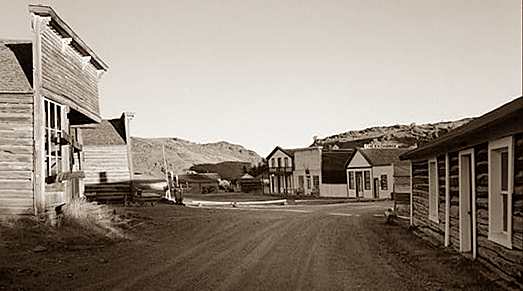
The town got its name from South Pass, the point where the Oregon Trail
crossed the Continental Divide. Unlike many other western towns that
have seen better days in the boom and bust cycle of the search for gold,
South Pass City lives on. Founded in 1867 during the closing last two
years of the Oregon Trail, there was talk early on that it would rival
Denver in its wealth, importance and population. One of the most
authentic large historic sites in the nation, it's 25—out of the
original 300—historic log, frame, and stone buildings live again thanks
to loving care and preservation.
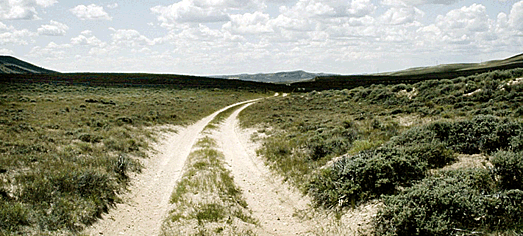
The Discovery of Gold
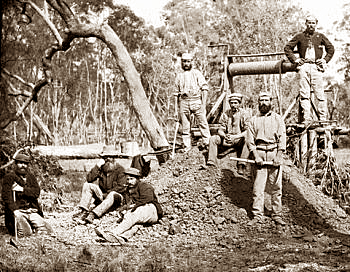 Beginning
in the 1860s, scattered handfuls of frontier military personnel
protected telegraph lines, Pony Express stations, and emigrant trails in
the South Pass area. The first sizable gold excitement in the South Pass
region took place when a party of men out of Fort Bridger located the
Cariso Lode, later called the Carissa Mine, in June 1867. A prolonged
bust quickly followed the initial gold rush as eager miners and
investors came to realize the realities of profitably working the claims
in the Sweetwater River area. Beginning
in the 1860s, scattered handfuls of frontier military personnel
protected telegraph lines, Pony Express stations, and emigrant trails in
the South Pass area. The first sizable gold excitement in the South Pass
region took place when a party of men out of Fort Bridger located the
Cariso Lode, later called the Carissa Mine, in June 1867. A prolonged
bust quickly followed the initial gold rush as eager miners and
investors came to realize the realities of profitably working the claims
in the Sweetwater River area.
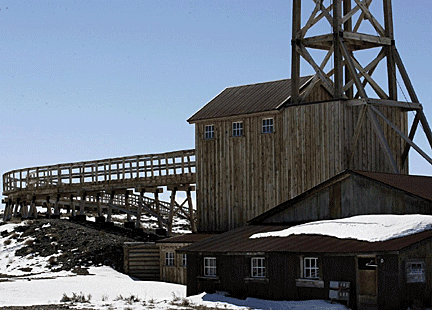 The
gold rush lasted only about four years. Besides the Carissa, twenty-five
larger mines, with colorful names like King Solomon's, Northern Light,
Hoosier Bay, and Mohamet, and hundreds of smaller ones operated at its
peak. The population of South Pass City grew to 3,000 and at one point
the townspeople thought it would become the new capitol of the Wyoming
Territory. They hoped that the transcontinental railroad would come up
the Sweetwater River, then follow the route of the Oregon Trail. When
the railroad decided to locate their route 90 miles south of town, that
pretty much killed the town, since by this time the placer gold found in
the stream gravel was all played out. They had to start doing hard rock
mining, and they simply couldn't get the equipment that they needed. The
gold rush lasted only about four years. Besides the Carissa, twenty-five
larger mines, with colorful names like King Solomon's, Northern Light,
Hoosier Bay, and Mohamet, and hundreds of smaller ones operated at its
peak. The population of South Pass City grew to 3,000 and at one point
the townspeople thought it would become the new capitol of the Wyoming
Territory. They hoped that the transcontinental railroad would come up
the Sweetwater River, then follow the route of the Oregon Trail. When
the railroad decided to locate their route 90 miles south of town, that
pretty much killed the town, since by this time the placer gold found in
the stream gravel was all played out. They had to start doing hard rock
mining, and they simply couldn't get the equipment that they needed.
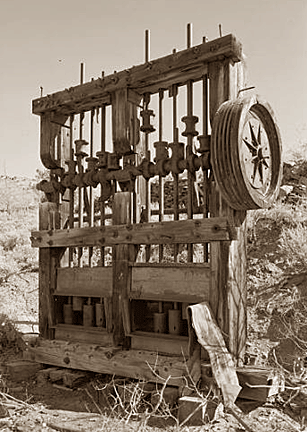 Unfortunately,
the strikes in the South Pass City area turned out not to be as
productive as everyone hoped and no one found a "Mother Lode." The
community began to fade in 1872. However, a series of smaller booms
occurred later on. Whenever the national economy turned downward and the
nation would go into a recession or depression, the interest in gold
mining would have a resurgence and people would move back into town and
reopen the old mines. They'd work them for a year or two, then they'd go
broke and their kids would go hungry and they'd move away. When things
got better in the rest of the country, they'd try to find a real job
somewhere else. Unfortunately,
the strikes in the South Pass City area turned out not to be as
productive as everyone hoped and no one found a "Mother Lode." The
community began to fade in 1872. However, a series of smaller booms
occurred later on. Whenever the national economy turned downward and the
nation would go into a recession or depression, the interest in gold
mining would have a resurgence and people would move back into town and
reopen the old mines. They'd work them for a year or two, then they'd go
broke and their kids would go hungry and they'd move away. When things
got better in the rest of the country, they'd try to find a real job
somewhere else.
Nothing can compare to that first boom in 1867 when thousands of miners
suddenly rushed into the area near the place where the Oregon Trail
crosses the Rockies at South Pass at the news of the rich Carisso Lode
strike. The gold camp burst into existence within a few months. All the
businesses servicing the prospectors necessities followed almost
immediately. They included the usual proliferation of saloons, hotels,
breweries, general stores, brothels, and even a newspaper, the South
Pass News, and a bank. Such businesses appeared overnight because people
with experience in previous gold booms in California, Nevada, Colorado
and Montana and elsewhere knew the easiest way to make money in the gold
fields was to sell supplies to the miners rather than chip into solid
rock or pan the frigid streams themselves.
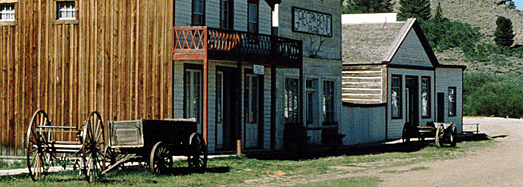
Notable Residents
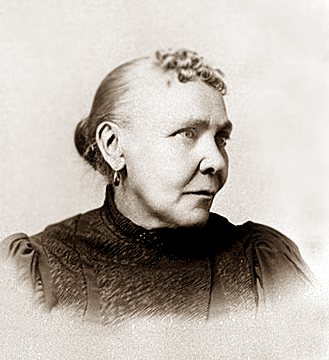 The
town owes a lot to one resident in particular, Janet Sherlock, a
Scottish immigrant, widow, and mother of five daughters who became the
operator of the South Pass Hotel, left a legacy for all to enjoy. She
came from Scotland and settled in Salt Lake City even before the
founding of South Pass City. She lived there for six years and met James
Smith, whom she married. The
town owes a lot to one resident in particular, Janet Sherlock, a
Scottish immigrant, widow, and mother of five daughters who became the
operator of the South Pass Hotel, left a legacy for all to enjoy. She
came from Scotland and settled in Salt Lake City even before the
founding of South Pass City. She lived there for six years and met James
Smith, whom she married.
James Smith was a Mexican War veteran born in Blackrock Ireland in 1840.
He emigrated with his parents when he was about 9 and signed on with a
merchant ships as a cabin boy and sailed all over the world. At 17, he
signed up with the Navy and saw action in the Mexican War. He mustered
out of the service at the Brooklyn Navy yard in 1848 and was given a
land grant in California. The military did this to encourage the
soldiers and sailors that were mustered out of the service to go settle
in California. So he shipped out and went to California and then went to
San Francisco and applied for a land grant in 1849. He went through
Panama and worked on board ship to pay passage.
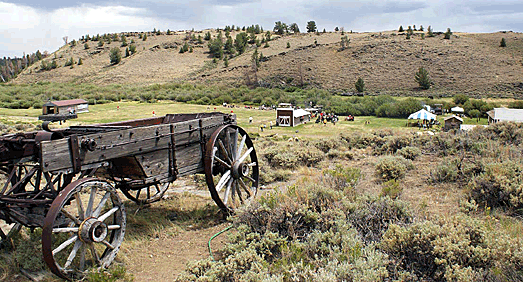
He ran a a
steamboat up to the gold fields from San Francisco for a while. Then he
ran a sloop picking up lumber in Monterrey, California, taking it to
Lima, Peru and going over to Tahiti. He had some experience at gold
fields in California and started doing some placer mining. The story
goes he was in one of the gold camps in California and was either shot
in the head—came out of his sinuses 15 years later—was lodged in his
head. He went to Arizona and Colorado and ended up in Montana in 1867
when the first news of the gold strike here in the Sweetwater area came
about and was one of the original gold people who came here in the
Spring of 1867 and staked out several choice business locations in town.
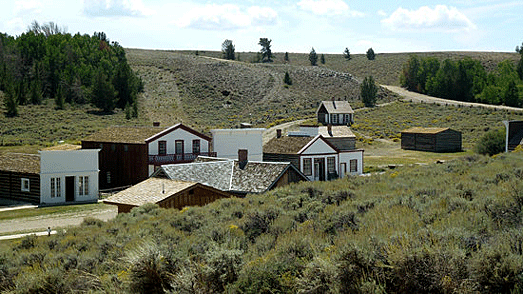
The next year in 1868 when South Pass City became a boom town, these
locations became really valuable property. He picked up several gold
claims that started up about a mile from town and essentially became a
success. He began one of the most prosperous businesses in the area—mine
speculation. He would buy a piece of property and then sell it to
someone else for a profit. All he had to do was convince the buyer that
the property was worth more than what he paid for it.
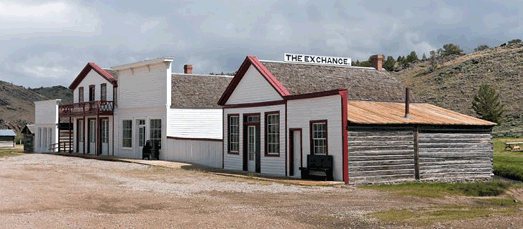
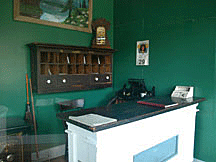 And
that's how the Smith Sherlock Company got started. He also owned a store
while he was speculating. Purchasing the Idaho House Hotel in 1873 and
promptly renaming it the South Pass Hotel, Janet Sherlock turned it into
a business that supported a large extended family for the next 80 years.
Soon after taking over the hotel, she married James Smith, the owner of
the general store. This began the dynasty of the Sherlock-Smith family
which lasted until 1948. And
that's how the Smith Sherlock Company got started. He also owned a store
while he was speculating. Purchasing the Idaho House Hotel in 1873 and
promptly renaming it the South Pass Hotel, Janet Sherlock turned it into
a business that supported a large extended family for the next 80 years.
Soon after taking over the hotel, she married James Smith, the owner of
the general store. This began the dynasty of the Sherlock-Smith family
which lasted until 1948.
Janet’s
brother was shot to death in the hotel over a card game, just like in
the movies. Robert Todd Lincoln stayed in this hotel, one of seven such
establishments in 1868, so did General Sheridan and other notables.
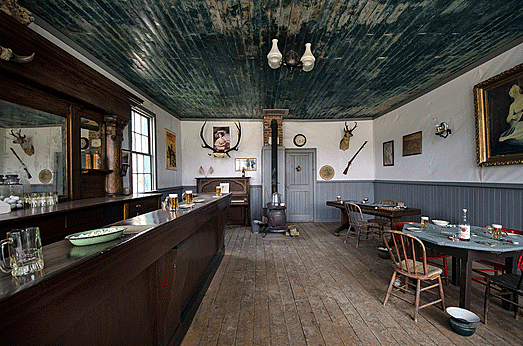
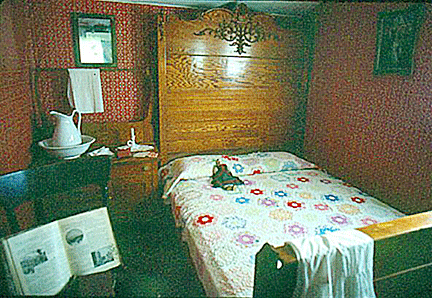 South
Pass City was on the main north-south route to Yellowstone. The South
Pass Hotel, then known as the Idaho House, had a contract with the stage
company. Its walls were just two boards nailed together. Guests who
stayed there anytime other than July would wake up in the morning with
ice on top of their blankets. But it sure beat sleeping in the snow. South
Pass City was on the main north-south route to Yellowstone. The South
Pass Hotel, then known as the Idaho House, had a contract with the stage
company. Its walls were just two boards nailed together. Guests who
stayed there anytime other than July would wake up in the morning with
ice on top of their blankets. But it sure beat sleeping in the snow.
The stagecoach used to stop at Janet Smith’s hotel twice a day—at Noon
and 2 A.M. Janet Smith hardly got any sleep since each stage carried 17
people. She would have to cook all night to prepare for them and cook
all day to prepare for her hotel guests. Her daughters waited tables,
helped cook the food, and scrubbed the tabletops, and did the laundry.
This was a rough place to live, especially for women, because the
weather was so gruesome in the winter.
The Janet Smith Tibbals Collection
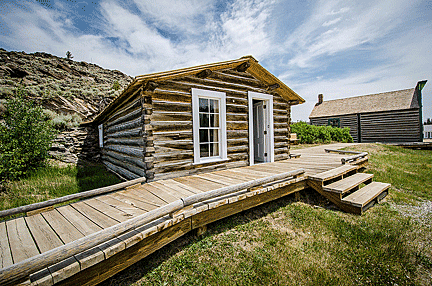 One
of Janet’s daughters, Anna Smith, began collecting South Pass
memorabilia at the age of seven. Eventually she assembled a huge number
of objects, including vintage clothing, papers, and personal
belongings--all labeled according to whom they belonged and what they
were used for--which she stored at her family's ranch in Pinedale.
Included were hundreds of photographs with the photographer's name, date
and subjects' names written on the back. One
of Janet’s daughters, Anna Smith, began collecting South Pass
memorabilia at the age of seven. Eventually she assembled a huge number
of objects, including vintage clothing, papers, and personal
belongings--all labeled according to whom they belonged and what they
were used for--which she stored at her family's ranch in Pinedale.
Included were hundreds of photographs with the photographer's name, date
and subjects' names written on the back.
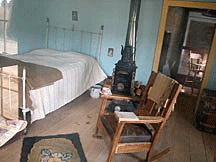 Whenever
a member of the oldest generation would pass on, Anna would come over
with a stock truck and load up all their belongings and take them over
to Pinedale. When her daughter, Janet Smith Tibbals, died in 1989
without a will, the folks who ran South Pass City as a state historic
site went over to the ranch and couldn't even open the doors there was
so much. This vast collection of items, added to over the years, went on
the auction block. Whenever
a member of the oldest generation would pass on, Anna would come over
with a stock truck and load up all their belongings and take them over
to Pinedale. When her daughter, Janet Smith Tibbals, died in 1989
without a will, the folks who ran South Pass City as a state historic
site went over to the ranch and couldn't even open the doors there was
so much. This vast collection of items, added to over the years, went on
the auction block.
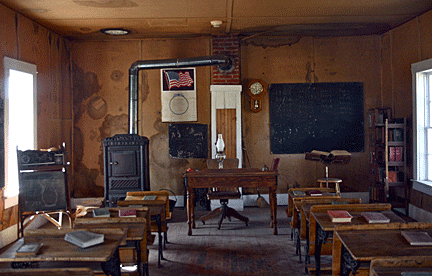 Michael
Fox, a cousin of Janet Smith Tibbals, was put in charge of doing an
inventory of her estate. He personally gave over 10,000 artifacts to the
site, and the State of Wyoming purchased 12,000 more, creating the Janet
Smith Tibbals Collection, one of the most complete in the West. A
special legislative appropriation helped erect a new laboratory and
storage facility to maintain the collection. Michael
Fox, a cousin of Janet Smith Tibbals, was put in charge of doing an
inventory of her estate. He personally gave over 10,000 artifacts to the
site, and the State of Wyoming purchased 12,000 more, creating the Janet
Smith Tibbals Collection, one of the most complete in the West. A
special legislative appropriation helped erect a new laboratory and
storage facility to maintain the collection.
South Pass City has been blessed with a tremendous wealth of
information. The historical depth of the collection doesn't exist
anywhere else. Stories, passed down from generation to generation, tell
who died in which bed and about Butch Cassidy, when he used to stand in
the doors of the old bank and flip silver dollars. The kids on the
street called him Uncle Butch.
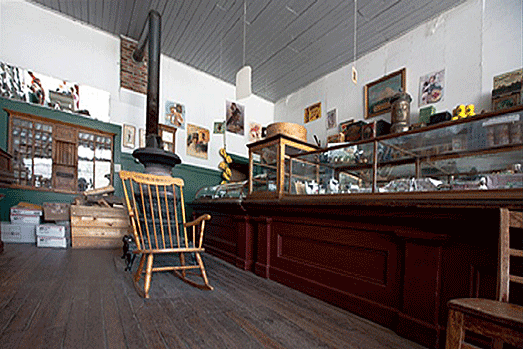
The community began to fade in 1872. and then there was a series of
small booms- Whenever the national economy turns downward, the interest
in gold mining encouraged people to move back, reopen the old mines, and
work them for a year or two. Then they would go broke and their kids
would be hungry and they'd move away.
South Pass City Today
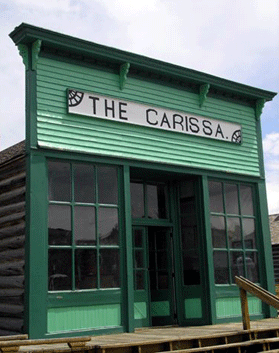 In
1874, James Smith built the structure which housed his mercantile
business for 20 years. Today, it exhibits the processes of gold mining
in the Sweetwater mines as well as videos on local geology. In
1874, James Smith built the structure which housed his mercantile
business for 20 years. Today, it exhibits the processes of gold mining
in the Sweetwater mines as well as videos on local geology.
He also built the Carissa Saloon around 1890. It takes its name from the
area's richest gold mine. The Carissa was a simple affair, offering
basic furnishings & refreshments to customers.
All of the historic structures in town still have their original
contents exhibited in the same rooms where people used them. Two-story
buildings lined the main street, South Pass Avenue, all the way to the
hills at the edge of town and for three-fourths of a mile to the west.
The town appears today much the way it did in the mid-1880s.
Across the street stood the millinery, next to that the livery stable.
The bank later became a saloon. Peering through the windows of these old
buildings visitors can see the real Old West. Here, the actual pieces of
furniture, dishes, clothes, and tools that the townspeople used remain
in a perfect state of preservation. Definitely not a dilapidated ghost
town, South Pass City is more than realistic—it's reality.

Because
the winters are so harsh, South Pass City State Historic Site is only
open during the warmer months from
<
Back to More Antiques to View
Next Article > |
